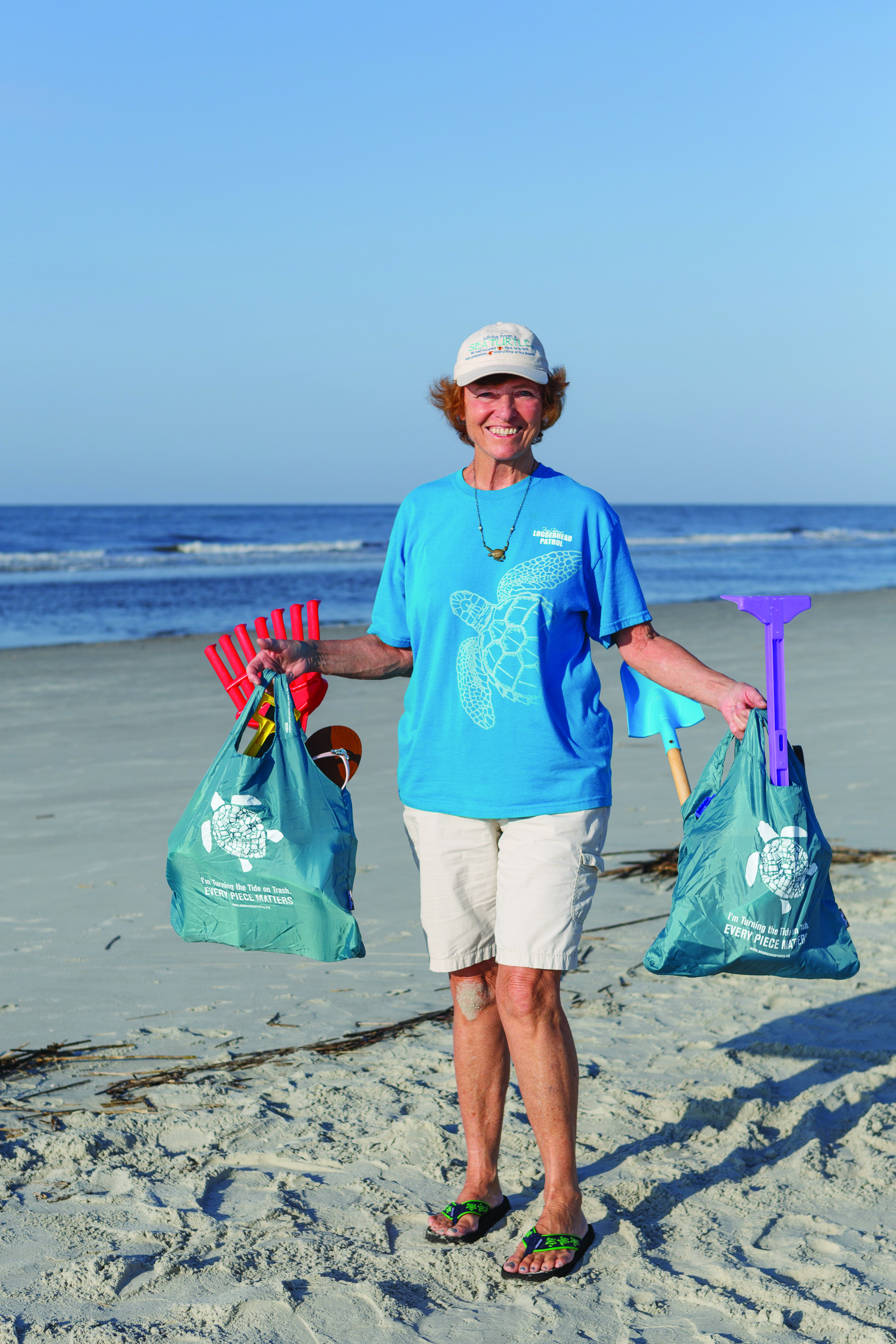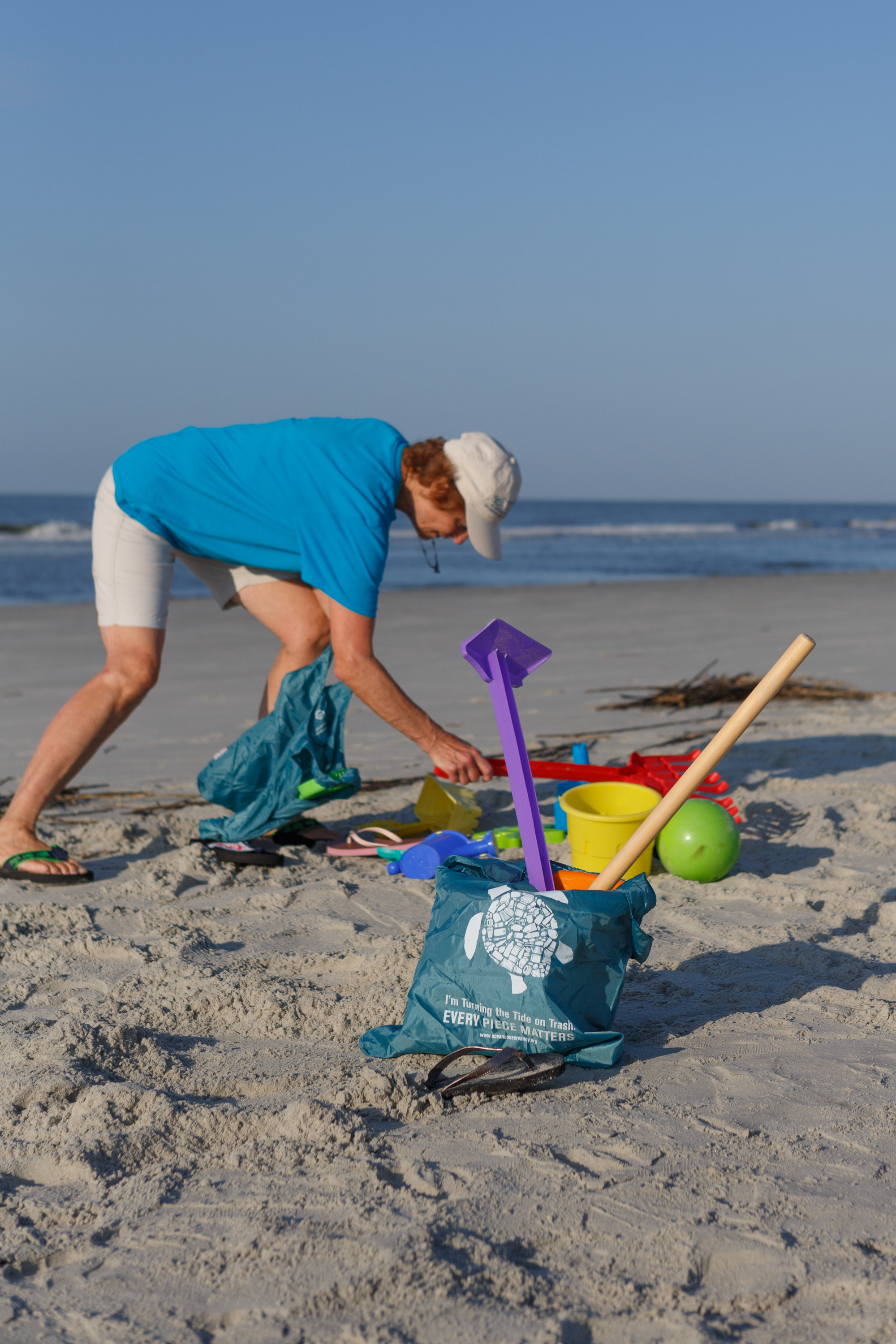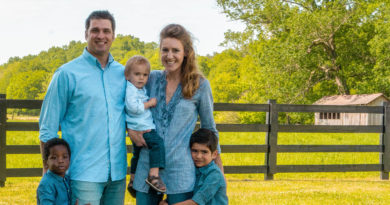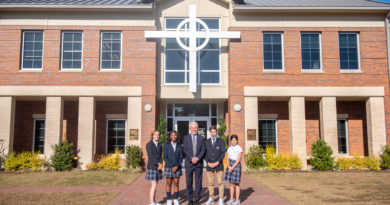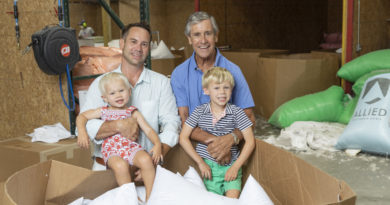Judy DaynEr: Cleaning Our Beaches… Minimizing Trash, Maximizing Turtles
Adding to a long list of interests and accomplishments, Judy Dayner is
now officially a bag lady, a beach trash bag lady. Spearheading the
Fripp Island Turtle Team’s Ocean Conservancy program, Minimizing
Trash, Maximizing Turtles, Judy can be found picking trash up on the
beach and cataloging it in an app on her phone which sends the
information straight to a data collection center. Ocean Conservancy
(OC) is trying to help save one of her favorite creatures – the sea
turtle. Judy and her husband of 47 years, John, planned for and
retired to Fripp Island thirteen years ago so they could help take
care of the turtles.
Fripp Island’s Turtle Team has recently joined OC’s program which
includes about 26 other beaches in the Carolinas, Georgia and Florida;
their collective goal is to see what is washing up on the beaches and
then try to find its sources. “Ocean Conservancy,” according to their
website (oceanconservancy.org), “educates and empowers citizens to
take action on behalf of the ocean. From the Arctic to the Gulf of
Mexico to the halls of Congress, Ocean Conservancy brings people
together to find solutions for our water planet. Informed by science,
our work guides policy and engages people in protecting the ocean and
its wildlife for future generations.”
This particular program, part of International Coastal Cleanup,
is geared toward protecting the turtles. However, Judy points out, “So
many important things come from the sea; for instance, half of the
oxygen we breathe comes from the ocean. Quite a bit of industry and
the jobs therein all over the world come from the ocean. The kinds and
amounts of trash that wash up on beaches are amazing. One of the most
destructive for the turtles is plastic bags which the turtles mistake
for their favorite food source, the jellyfish.”
In 2014, info-graphics that were put together by OC show that
648,015 volunteers collected 12,329,332 pounds of trash in 12,914
miles. Leading the list were 2,043,470 cigarette butts, followed by
food wrappers, plastic beverage bottles, bottle caps, straws and
plastic bags. Among of the more interesting finds were a 1904
typewriter, a guitar, a pink tutu, a plastic eye ball and a voodoo
doll in a jar.
Members of the Fripp Island Women’s Club put their beach trash to
good use when, in 2013, they decorated their community Christmas tree
with toys found on the beach and surrounded it with layers of boogie
boards. In 2014, the Christmas tree was decorated with discarded flip
flops, which goes to show that one man’s trash can be another man’s
treasure, except that beach trash is harmful to wildlife, swimmers,
boaters and the environment in general. The app that Judy uses,
cleanswell, has a list of the most commonly found items. You check
them off as you find them and they are instantly recorded. That list
can also be printed out from their website and mailed in. The OC
provided the Fripp Island Turtle Program with laminated sheets listing
common trash items so the sheets can be reused. The OC also states
trash be picked up in recyclable bags rather than plastic trash bags.
One of Judy’s favorite turtle events is the annual Totally Turtle
Week at Fripp. The 2015 Turtle Crawl 5K will be held on July 17 at the
Fripp Island Beach Club and is open to everyone. Judy’s friend Fripp
Island Turtle Program Director Janie Lackman, invites everyone: “This
family fun event will feature both a 5K race as well as a 1 Mile Fun
Walk/Run. Proceeds benefit the Fripp Island Turtle Program, a 501(c) 3
non-profit volunteer nest protection program permitted by the SC
Department of Natural Resources and dedicated to the conservation of
sea turtles and educating the public about his amazing species.
Sign-up today to join the FUN and do our part to help our state
reptile, the loggerhead sea turtle.
Judy adds, “We are a strictly volunteer organization, with 46
volunteers this summer. The 2014 Turtle Crawl was so successful that
The Fripp Island Turtle Team donated $10,000 to the Sea Turtle
Hospital in Charleston. We hope this year’s Turtle Crawl will be even
more successful. Volunteers work in patrols that meet at 6:30 a.m. to
walk the Fripp beach looking for nests; we rope them off to keep them
safe, or we move them if they were laid too close to the high tide
line. We monitor nests each day, and when nests hatch, after three
days, we inventory them.”
When Judy and John are not enjoying the beach and the turtles at
Fripp, they may be relaxing in their North Beach Haven house on Long
Beach Island, New Jersey, or they are indulging in Judy’s favorite
pastime, traveling in their RV. “Actually,” she admits, “I’m addicted
to RV-ing.” Judy was a biology teacher and science supervisor in
Bergen County, NJ, and John was a language arts supervisor. They met
when they were students at the University of Connecticut. “It all
started when we bought a VW camper, then we had our son, got a dog,
and had a daughter. Every year, on the day after school got out, we
packed up everyone in that camper and took off across the United
States and Canada.”
About one of those RV trips, Judy recounts, “Years ago when our
son and daughter were little, we used to camp every summer for two
weeks at Huntington Beach State Park in Murrells Inlet. That was
before there were many restrictions on handling sea turtles. We used
to go on all the nature hikes and talks, and one year the naturalist,
Julie, moved a nest that was in danger of being destroyed by high
tides. She put the eggs in a children’s plastic swimming pool filled
with sand from the beach and they incubated there. We were there when
they hatched, and Julie asked us to help with releasing the
hatchlings. Both our son and daughter got to carefully carry
hatchlings down the beach; then they eagerly watched as the baby
turtles scurried to the sea.
“Our daughter, Dr. Jennifer Crotty, is an assistant professor of
pediatrics in Greenville,NC. Our son, Dr. Jeremy Dayner, is a board
certified emergency medicine physician and chair of the Department of
Emergency Medicine in Freehold, NJ. Both were biology majors in
college, and both tell people that those summers in Huntington Beach
changed their lives.
“Now our four grandchildren love to come to Fripp to see the
turtle tracks in the morning, watch as the turtle patrol moves eggs,
and see hatchlings go to the ocean. I’m thrilled that this new
generation is so excited about sea turtles; they’ll help keep them
safe in the future.”
Another of the Dayners’ passions is shag dancing. “We bought our
home on Fripp in 1985 and we rented it out full time for years until
we retired in June of 2002. That fall we saw people dancing the shag
and I saw an announcement in a Beaufort paper inviting people to come
to Lady’s Island Country Club for a shag dance. We went, and we were
the only people who had no idea how to shag. The DJ asked if we’d like
lessons, so we started learning the Carolina Shag. In 2003, a new club
formed, the Beaufort Shag Club, and my husband and I are charter
members. John was on the board for two years, then I ran for election.
This is my third year on the board, I’ve been the vice president, the
director of membership, and the president for a short time. We love
the dance and the many wonderful friends we’ve met in Beaufort, North
Myrtle Beach and on the shag cruises. Every year a large group of us
from Beaufort attend Society of Stranders in North Myrtle Beach where
three times a year hundreds of shaggers from all over meet to dance
and have fun. We learn new steps, have a huge parade in April and a
big concert in September. Great fun. We also attend events at other
shag clubs, and people from other clubs visit us. For the last two
years the Beaufort Shag Club hosted a well-known shag band, The
Holiday Band, at the Shed in Port Royal and shaggers from all over
attended.”
When you see Judy walking down the beach putting beach trash in a
recyclable bag, or searching for turtle tracks, and maybe with just a
little dance to her step, catch up, match her stride and help yourself
to some turtle fever. With energy and enthusiasm to share, this may be
what you’ll hear her say, “This morning Janie Lackman, another
volunteer, and I found and relocated 144 eggs to a safe zone on the
north beach. As I picked up the eggs (with gloves of course) I thought
that most of embryos will hatch into hatchlings; however, few of the
hatchlings will make it to adulthood. The males that make it will
never return to our beach, and the females will return to the
Lowcountry beaches twenty five or thirty years from now. Pretty
amazing.”
story by mary ellen thompson photography by susan deloach

